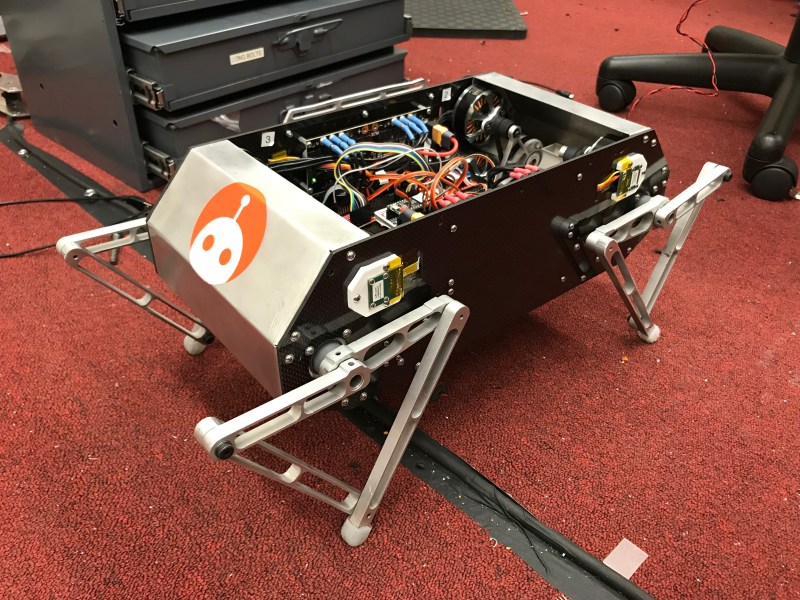Members of Stanford Student Robotics’ Extreme Mobility team have developed a four-legged robot that can walk, jump and even do a backflip. On May 21, Aaron Schultz ’20 and Nathan Kau ’20 presented Stanford Doggo at the IEEE International Conference on Robotics and Automation (ICRA) in Montreal, Canada.
All instructions and code for building the robot, called Stanford Doggo, are open-source and accessible on the online project page, with further details in the team’s paper.
The Extreme Mobility team, started by Kau in the 2017-18 academic year, was borne out of an interest in building legged robots. Stanford Doggo arose as the team researched existing legged-robot projects.
“We found that there really weren’t many projects where people have published what they’ve done and how you can build your own,” Schultz said. “So that’s why we decided we were going to build our own and then make it available, so that other people in the future would be able to have something to go off of.”
According to Schultz, the team began by making prototypes of single legs. Many other similar robots use a single knee joint, but the Extreme Mobility team chose a kite-shaped design for the legs of their robots because the design was particularly good for jumping. Once the team had decided on the design for the legs, the next steps were producing four of them and attaching them to a single body.
Currently, Stanford Doggo holds the record among all robots for vertical jumping agility, which is how fast and high the robot can jump.
While developing Stanford Doggo, the students ran many tests, said mechanical engineering Ph.D. candidate Patrick Slade, who helped the team consider how they could frame their work within broader research questions and produce the robot cost-effectively. Building Stanford Doggo costs less than $3,000, a modest price compared to other similar research-created robots.
“What we tried to do was use manufacturing techniques that are cheap and could be done through services online,” Slade said. “You could send files to make these parts to a company, and they would cut them for you and ship the parts to you. All you would need to do is have hand tools like drills and screwdrivers, and you could take all these parts that were produced easily online, and then assemble them yourself.”
Slade acknowledged that some maneuvers are challenging for Stanford Doggo. For example, the robot’s legs can only move back and forth in a plane, so Stanford Doggo must shuffle in order to turn. Additionally, it is challenging for Stanford Doggo to correct itself if it gets off balance while doing a flip.
The team is keeping in mind these challenges as it works on ways to extend Stanford Doggo’s capabilities. A potential extension of Stanford Doggo would be enabling it to interact with people, Slade said, such as by carrying objects.
In addition to Stanford Doggo, the Extreme Mobility team is developing a similar yet larger version called Stanford Woofer. The legs of Stanford Woofer have the same design style, but added shoulder joints allow the legs to rotate as well, enabling more complex movements.
The motors on Stanford Woofer are around twice the size of those on Stanford Doggo, but also around three times as powerful. The team expects Stanford Woofer to jump twice the height of Stanford Doggo, Schultz said.
Much of the mechanical side of Stanford Woofer’s development is complete, and now the team is focusing on allowing Stanford Woofer to stand, run, jump and more. The team hopes to work on Stanford Woofer over the summer and in the coming academic year so that Stanford Woofer not only can execute the same basic functions as Stanford Doggo, but also perform more advanced controls.
Contact Michelle Leung at mleung2 ‘at’ stanford.edu.
